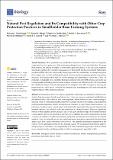| dc.description.abstract | Common bean (Phaseolus vulgaris) production and storage are limited by numerous con-
straints. Insect pests are often the most destructive. However, resource-constrained smallholders in
sub-Saharan Africa (SSA) often do little to manage pests. Where farmers do use a control strategy, it
typically relies on chemical pesticides, which have adverse effects on the wildlife, crop pollinators,
natural enemies, mammals, and the development of resistance by pests. Nature-based solutions —in
particular, using biological control agents with sustainable approaches that include biopesticides,
resistant varieties, and cultural tools—are alternatives to chemical control. However, significant
barriers to their adoption in SSA include a lack of field data and knowledge on the natural enemies
of pests, safety, efficacy, the spectrum of activities, the availability and costs of biopesticides, the lack
of sources of resistance for different cultivars, and spatial and temporal inconsistencies for cultural
methods. Here, we critically review the control options for bean pests, particularly the black bean
aphid (Aphis fabae) and pod borers (Maruca vitrata). We identified natural pest regulation as the
option with the greatest potential for this farming system. We recommend that farmers adapt to
using biological control due to its compatibility with other sustainable approaches, such as cultural
tools, resistant varieties, and biopesticides for effective management, especially in SSA. | en_US |

